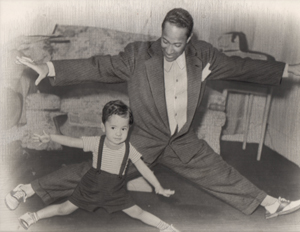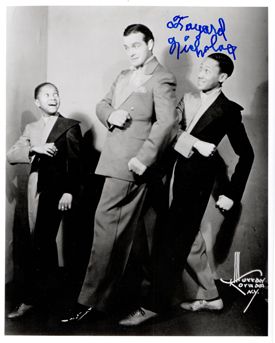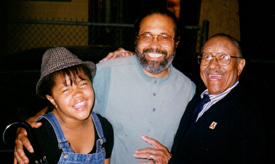The Nicholas Brothers Remembered
- Details
- Category: Interviews
- Published on Sunday, 11 October 2015 00:36
- Written by Chelsee Lowe
 Fayard and Harold Nicholas made a name for themselves with their feet. From the ages of 14 and 7, the brothers impressed crowds worldwide with their electric tap dancing skills. Though they passed in 2006 and 2000 respectively, the Nicholas Brothers’ legacy lives on through their children, grandchildren and great grandchildren, including Tony Nicholas, director of Tom Bradley International Source Center on Pico Boulevard. Tony, son of Fayard Nicholas, hopes to stage a Nicholas Brothers tribute show at a local theater soon. He spoke with The Neighborhood News about his father’s life in Los Angeles and beyond.
Fayard and Harold Nicholas made a name for themselves with their feet. From the ages of 14 and 7, the brothers impressed crowds worldwide with their electric tap dancing skills. Though they passed in 2006 and 2000 respectively, the Nicholas Brothers’ legacy lives on through their children, grandchildren and great grandchildren, including Tony Nicholas, director of Tom Bradley International Source Center on Pico Boulevard. Tony, son of Fayard Nicholas, hopes to stage a Nicholas Brothers tribute show at a local theater soon. He spoke with The Neighborhood News about his father’s life in Los Angeles and beyond.TNN: What will the upcoming tribute show be like?
Tony Nicholas: What we’ve done is taken Nicholas Brothers moments — pictures, film clips of dance routines, plus two reenactments — and combined them into an amazing show. It begins with family members on stage. The MC usually asks us a series of questions and we tell stories. After that, my two grandchildren come out. A clip from the film “Lucky Numbers” plays behind them, and they sing the song with the clip. After that, my daughters come on stage to do the “Lucky Numbers” tap routine. It’s incredible.
TNN: You’ve shared that four generations of your family have tap danced at this point. How did that tradition begin?
Tony: My father was born in 1914 in Mobile, Ala., and my uncle was born seven years in later in Winston-Salem, N.C. My grandparents later moved to Philadelphia — they were in Vaudeville, and they performed the Vaudeville circuit along the east coast. My grandmother played the piano, my grandfather played the drums, and they had a base player in their group. My father would travel with them as well. He’d be in the audience, watch the dancers and mimic them. He taught himself how to dance, and later he taught his brother.
 Tony with Dad Fayard
Tony with Dad FayardTNN: How did they become professional dancers?
Tony: One day, my father and uncle performed for their parents. And in regular church shoes, because tap shoes weren’t a thing yet. My grandfather knew there was something there. My grandparents quit Vaudeville and started promoting their kids. My father was 14 and my uncle was 7.
They started at the famous Standard Theater in Philly. A promotor saw them dance and said, “Listen, I wanna bring you to New York City to perform at the Cotton Club.” And they did. They were there with all the famous black entertainers of that time — Lena Horne, Count Basie, Duke Ellington and more. The Nicholas Brothers were so talented that none of the other acts wanted to follow them. So they had to close the show every night. They did that for years. Then Hollywood called.
TNN: What happened when they came to L.A.?
Tony: They just visited at first — they shot the film “Kid Millions” — then they went back to The Cotton Club. But when the venue closed down in 1940, they went to Europe to find work — black performers were well-loved in Europe, so there were more jobs there than in the U.S. When World War II started, they returned to the states. My father was drafted and he became a part of the United Service Organization. He performed for the soldiers.
TNN: What happened when the war ended?
Tony: When my father got out of the army, he and my uncle signed a contract with 20th Century Fox to do six films. They lived here in L.A. at that point, and by then my father had married my mother, who he met while performing in Chicago. She wanted to buy a house on the westside of L.A. but she wasn’t allowed to. At that time, blacks couldn’t buy homes west of Arlington. She tried to buy a house right on Arlington, but when nothing was available she went one street over. We lived on Van Ness, a couple of blocks north of Exposition.
(One block over, was Cimmaron where Eddie Anderson, the African American actor who played Jack Benny's butler Rochester, built a house that was the exact replica of Jack Benny's. He was not allowed to buy in Beverly Hills.) Our family bought the house in 1945, around the time I was born. Mom started picketing City Hall around then as well. There was a photo of her, myself in a buggy and a sign that reads, “L.A. is Unfair to Negros” in the L.A. Times.
With Bob Hope

TNN: How did the filming of the movies go for The Nicholas Brothers?
Tony: They shot the films from 1945 to 1951. But one of my favorite stories is from the signing day. They went to see Darryl F. Zanuck, head of 20th century Fox and one of the most powerful men in all of Hollywood. Zanuck said he wanted to find another star on the grounds — he wanted someone to take a photo with my father and uncle as they signed the contract. So he told them to go have lunch. They went to the commissary and were turned away by the maitre d’, who told them they had to go around back and get sandwiches. An executive saw what happened, told Zanuck, and Zanuck came down and fired everyone. That same day — that quick — he got new workers, found my father and uncle and had lunch with them in the commissary. He also found Fred Astaire. So Fayard and Harold danced with Fred Astaire right there on the lot, and my uncle’s valet recorded it on his video camera.
TNN: Many other incredible stories unfolded for them — and you — as they continued to dance. Can you share another of your favorites?
Tony: After the contract film wrapped, we headed back to Europe. At one point, we were staying at a villa in Rome. I was dancing by then, too. I was 5 years old. One day, a priest came up to us, talked to my mother, and we got in a limo that took us to the Vatican. We were ushered in to see the Pope, and I danced for him. I had been performing with the Nicholas Brothers, and he had heard wind of this little dancer. He wanted to see me for himself. We have it all on film, too. And he gave me a special blessing — that’s why I feel I’ve been blessed all my life.
 With Dorothy Dandridge
With Dorothy DandridgeTNN:Were there any other one-of-a-kind performances?
Tony: Not too long after that, we moved to Paris then London, where we gave a command performance for Queen Elizabeth. She was in the royal box and pregnant. She went into labor and had to leave, but the Queen Mother stayed — she wouldn’t leave until she’d seen us. After The Nicholas Brothers performed, I had my turn. The next day, the Queen Mother invited us to Buckingham Palace — we have a film of her holding my hand and walking through the rose garden. I’ve been waiting to meet that child — Prince Charles — to tell him that his grandmother wasn’t at his birth because she wanted to see me dance. And all of these home movies are stored at the Motion Picture Academy here in L.A. You can go watch them! They’re also part of the National Library of Congress.
TNN: What did your father's dancing career look like in his later years?
Tony: My mother and father had problems, and eventually she divorced him and we came back to the house on Van Ness. Tap dancing fell in popularity in the 50s and 60s — my father took work as a night watchman at a L.A. factory. But then in the 1970s, tap dancing came back, with a little help from Gregory Hines and Sauvignon Glover. People rediscovered The Nicholas Brothers. My uncle came back from Europe, where he’d stayed and performed solo. They started working in television, at the Hollywood Palace, everywhere. They performed before seven presidents; they received a Kennedy Center Award in the 1990s. Eventually, my own daughters were dancing, too. As a family, they danced together at Carnegie Hall, at the Hollywood Palladium, even in Cuba.
TNN: What a legacy. What about the fourth generation?
 Tony: I have two grandchildren now, and they’re dancing— they’re good and they love it. My granddaughter was here [at the Tom Bradley International Source Center] the other day. Someone asked her, “What do you want to be?” She said, “A doctor, but I want to be a dancing doctor.”
Tony: I have two grandchildren now, and they’re dancing— they’re good and they love it. My granddaughter was here [at the Tom Bradley International Source Center] the other day. Someone asked her, “What do you want to be?” She said, “A doctor, but I want to be a dancing doctor.”Watch one of the most famous Nicholas Brothers' performances at
www.youtube.com/watch?v=zBb9hTyLjfM
Categories
-
Featured Local Business
Fais Do Do. 28 Years Strong
 Standing like a sentinal at the entrance of what I like to refer to as the West Adams Gateway...
Standing like a sentinal at the entrance of what I like to refer to as the West Adams Gateway...
-
Featured Resident
The Editor Discovers Her Remarkable Ancestors
 I was born out of wedlock in 1951 to a beautiful Latvian immigrant woman, Inta Penka. In 1940...
I was born out of wedlock in 1951 to a beautiful Latvian immigrant woman, Inta Penka. In 1940...
-
Featured Teen
Roy Readmond
 While grandparents despair that the younger generation has been captured by twitter, instagram,...
While grandparents despair that the younger generation has been captured by twitter, instagram,...
-
Interviews
NEXT! Dianne V. Lawrence on wrapping up the hard copy of The Neighborhood News
 For 13 years, Dianne V. Lawrence has helmed The Neighborhood News, highlighting noteworthy...
For 13 years, Dianne V. Lawrence has helmed The Neighborhood News, highlighting noteworthy...
-
Leaders, Activists
Anthony Nicholas Remembers Rosa Parks
 This article is reprinted with permission from the World Tribune. For more information on that...
This article is reprinted with permission from the World Tribune. For more information on that...
Today7
Yesterday10
Week57
Month97
All988715
Kubik-Rubik Joomla! Extensions
Yesterday10
Week57
Month97
All988715
Currently are 9 guests and no members online
Kubik-Rubik Joomla! Extensions



